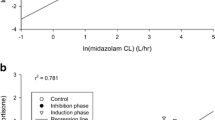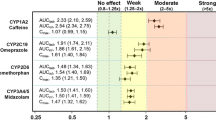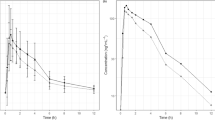Abstract
Cytochrome P450 (CYP) 3A is an important drug-metabolizing enzyme in humans. Assessing CYP3A activity is necessary for predicting therapeutic outcomes or the potential adverse events of various therapeutics. This study sought to evaluate the distribution of endogenous and exogenous markers reflecting hepatic CYP3A activity and related factors affecting its activity in healthy male and female. Each subject was given a single 1 mg dose of midazolam intravenously. Pharmacokinetics, pharmacometabolomics, and pharmacogenomics analyses were performed to evaluate CYP3A activity. Urinary and plasma steroids were quantified with gas chromatography coupled with triple-quadrupole mass spectrometry (GC-MS), and the concentrations of midazolam and its metabolites were quantified with liquid chromatography coupled with electrospray tandem mass spectrometry (LC-MS/MS). A total of 100 subjects completed this study. Midazolam clearance (MDZ CL) and the metabolic ratio (MDZ MR) were significantly correlated with 6β-OH-cortisol/cortisol and 6β-OH-cortisone/cortisone. MDZ CL, 6β-OH-cortisol/cortisol, and 6β-OH-cortisone/cortisone decreased with increasing age (Pearson r = −0.333, −0.329, and −0.528, respectively; P < 0.05). When the markers were compared according to sex, MDZ CL and 6β-OH-cortisol/cortisol showed significant difference between sexes. However, MDZ CL was higher in female group than male group and 6β-OH-cortisol/cortisol was higher in male group than female group. No significant differences in markers were found when comparing progesterone levels. Our results indicate that both exogenous and endogenous markers showed decreased CYP3A activity with increasing age, which suggested that age could be a factor that significantly influences CYP3A activity.




Similar content being viewed by others
References
Stevens JC, Hines RN, Gu C, Koukouritaki SB, Manro JR, Tandler PJ, et al. Developmental expression of the major human hepatic CYP3A enzymes. J Pharmacol Exp Ther. 2003;307:573–82. doi:10.1124/jpet.103.054841.
de Wildt SN, Kearns GL, Leeder JS, van den Anker JN. Cytochrome P450 3A: ontogeny and drug disposition. Clin Pharmacokinet. 1999;37:485–505. doi:10.2165/00003088-199937060-00004.
Zanger UM, Schwab M. Cytochrome P450 enzymes in drug metabolism: regulation of gene expression, enzyme activities, and impact of genetic variation. Pharmacol Ther. 2013;138:103–41. doi:10.1016/j.pharmthera.2012.12.007.
Perera MA, Thirumaran RK, Cox NJ, Hanauer S, Das S, Brimer-Cline C, et al. Prediction of CYP3A4 enzyme activity using haplotype tag SNPs in African Americans. Pharmacogenomics J. 2009;9:49–60. doi:10.1038/tpj.2008.13.
Dai ZR, Ai CZ, Ge GB, He YQ, Wu JJ, Wang JY, et al. A mechanism-based model for the prediction of the metabolic sites of steroids mediated by cytochrome P450 3a4. Int J Mol Sci. 2015;16:14677–94. doi:10.3390/ijms160714677.
Fahmi OA, Maurer TS, Kish M, Cardenas E, Boldt S, Nettleton D. A combined model for predicting CYP3A4 clinical net drug-drug interaction based on CYP3A4 inhibition, inactivation, and induction determined in vitro. Drug Metab Dispos. 2008;36:1698–708. doi:10.1124/dmd.107.018663.
Dutreix C, Lorenzo S, Wang Y. Comparison of two endogenous biomarkers of CYP3A4 activity in a drug-drug interaction study between midostaurin and rifampicin. Eur J Clin Pharmacol. 2014;70:915–20. doi:10.1007/s00228-014-1675-0.
Foti RS, Rock DA, Wienkers LC, Wahlstrom JL. Selection of alternative CYP3A4 probe substrates for clinical drug interaction studies using in vitro data and in vivo simulation. Drug Metab Dispos. 2010;38:981–7. doi:10.1124/dmd.110.032094.
James LP. Metabolomics: integration of a new "omics" with clinical pharmacology. Clin Pharmacol Ther. 2013;94:547–51. doi:10.1038/clpt.2013.166.
Shin KH, Choi MH, Lim KS, Yu KS, Jang IJ, Cho JY. Evaluation of endogenous metabolic markers of hepatic CYP3A activity using metabolic profiling and midazolam clearance. Clin Pharmacol Ther. 2013;94:601–9. doi:10.1038/clpt.2013.128.
Torimoto N, Ishii I, Hata M, Nakamura H, Imada H, Ariyoshi N, et al. Direct interaction between substrates and endogenous steroids in the active site may change the activity of cytochrome P450 3A4. Biochemistry. 2003;42:15068–77. doi:10.1021/bi034409n.
Nakamura H, Nakasa H, Ishii I, Ariyoshi N, Igarashi T, Ohmori S, et al. Effects of endogenous steroids on CYP3A4-mediated drug metabolism by human liver microsomes. Drug Metab Dispos. 2002;30:534–40. doi:10.1124/dmd.30.5.534.
Shin K-H, Ahn LH, Choi MH, Moon JY, Lee J, Jang IJ, et al. Urinary 6β-hydroxycortisol/cortisol ratio most highly correlates with midazolam clearance under hepatic CYP3A inhibition and induction in females: a pharmacometabolomics approach. AAPS J. 2016;18:1254–61. doi:10.1208/s12248-016-9941-y.
Tomalik-Scharte D, Lutjohann D, Doroshyenko O, Frank D, Jetter A, Fuhr U. Plasma 4β-hydroxycholesterol: an endogenous CYP3A metric? Clin Pharmacol Ther. 2009;86:147–53. doi:10.1038/clpt.2009.72.
Diczfalusy U, Miura J, Roh HK, Mirghani RA, Sayi J, Larsson H, et al. 4β-hydroxycholesterol is a new endogenous CYP3A marker: relationship to CYP3A5 genotype, quinine 3-hydroxylation and sex in Koreans, Swedes and Tanzanians. Pharmacogenet Genomics. 2008;18:201–8. doi:10.1097/FPC.0b013e3282f50ee9.
Li K, Zhao S, Zhang L, Wu X, Shu P, Wang Y, et al. 4β-Hydroxycholesterol as an endogenous biomarker of CYP3A activity in cynomolgus monkeys. Drug Metab Dispos. 2014;42:839–43. doi:10.1124/dmd.114.057224.
Marde Arrhen Y, Nylen H, Lovgren-Sandblom A, Kanebratt KP, Wide K, Diczfalusy U. A comparison of 4β-hydroxycholesterol: cholesterol and 6beta-hydroxycortisol: cortisol as markers of CYP3A4 induction. Br J Clin Pharmacol. 2013;75:1536–40. doi:10.1111/bcp.12016.
Lang LM, Linnet K. The ratio of 6β-hydroxycortisol to cortisol in urine as a measure of cytochrome P450 3A activity in postmortem cases. J Forensic Sci. 2014;59:1036–40. doi:10.1111/1556-4029.12418.
Chen YC, Gotzkowsky SK, Nafziger AN, Kulawy RW, Rocci ML Jr, Bertino JS Jr, et al. Poor correlation between 6β-hydroxycortisol: cortisol molar ratios and midazolam clearance as measure of hepatic CYP3A activity. Br J Clin Pharmacol. 2006;62:187–95. doi:10.1111/j.1365-2125.2006.02628.x.
Link B, Haschke M, Grignaschi N, Bodmer M, Aschmann YZ, Wenk M, et al. Pharmacokinetics of intravenous and oral midazolam in plasma and saliva in humans: usefulness of saliva as matrix for CYP3A phenotyping. Br J Clin Pharmacol. 2008;66:473–84. doi:10.1111/j.1365-2125.2008.03201.x.
Jabor VA, Coelho EB, Dos Santos NA, Bonato PS, Lanchote VL. A highly sensitive LC-MS-MS assay for analysis of midazolam and its major metabolite in human plasma: applications to drug metabolism. J Chromatogr B Analyt Technol Biomed Life Sci. 2005;822:27–32. doi:10.1016/j.jchromb.2005.05.011.
Zhao Y, Lui G, Shen JX, Aubry AF. Reasons for calibration standard curve slope variation in LC–MS assays and how to address it. Bioanalysis. 2014;6:1439–43. doi:10.4155/bio.14.71.
Shimizu M, Uno T, Tamura HO, Kanazawa H, Murakami I, Sugawara K, et al. A developed determination of midazolam and 1′-hydroxymidazolam in plasma by liquid chromatography-mass spectrometry: application of human pharmacokinetic study for measurement of CYP3A activity. J Chromatogr B Analyt Technol Biomed Life Sci. 2007;847:275–81. doi:10.1016/j.jchromb.2006.10.018.
Wang D, Sadee W. CYP3A4 intronic SNP rs35599367 (CYP3A4* 22) alters RNA splicing. Pharmacogenet Genomics. 2016;26:40–3. doi:10.1097/FPC.0000000000000183.
Andreu F, Colom H, Elens L, vann Gelder T, van Schaik RH, Hesselink DA, et al. A new CYP3A5*3 and CYP3A4*22 cluster influencing tacrolimus target concentrations: a population approach. Clin Pharmacokinet. 2017;2017:1–13. doi:10.1007/s40262-016-0491-3.
Oh J, Shin D, Lim KS, Lee S, Jung KH, Chu K, et al. Aspirin decreases systemic exposure to clopidogrel through modulation of P-glycoprotein but does not alter its antithrombotic activity. Clin Pharmacol Ther. 2014;95:608–16. doi:10.1038/clpt.2014.49.
de Graan AJ, Sparreboom A, de Bruijn P, de Jonge E, van der Holt B, Wiemer EA, et al. 4β-hydroxycholesterol as an endogenous CYP3A marker in cancer patients treated with taxanes. Br J Clin Pharmacol. 2015;80:560–8. doi:10.1111/bcp.12707.
Moon JY, Kang SM, Lee J, Cho JY, Moon MH, Jang IJ, et al. GC-MS-based quantitative signatures of cytochrome P450-mediated steroid oxidation induced by rifampicin. Ther Drug Monit. 2013;35:473–84. doi:10.1097/FTD.0b013e318286ee02.
Holazo AA, Winkler MB, Patel IH. Effects of age, gender and oral contraceptives on intramuscular midazolam pharmacokinetics. J Clin Pharmacol. 1988;28:1040–5. doi:10.1002/j.1552-4604.1988.tb03127.x.
Chen M, Ma L, Drusano GL, Bertino JS Jr, Nafziger AN. Sex differences in CYP3A activity using intravenous and oral midazolam. Clin Pharmacol Ther. 2006;80:531–8. doi:10.1016/j.clpt.2006.08.014.
Waxman DJ, Holloway MG. Sex differences in the expression of hepatic drug metabolizing enzymes. Mol Pharmacol. 2009;76:215–28. doi:10.1124/mol.109.056705.
Baldea AJ. Effect of aging on renal function plus monitoring and support. Surg Clin North Am. 2015;95:71–83. doi:10.1016/j.suc.2014.09.003.
Kharasch ED, Mautz D, Senn T, Lentz G, Cox K. Menstrual cycle variability in midazolam pharmacokinetics. J Clin Pharmacol. 1999;39:275–80. doi:10.1177/009127009903900311.
Acknowledgements
This research (2014R1A2A2A01005541) was supported by the Mid-career Researcher Program through a National Research Foundation (NRF) grant funded by the Korea government (MSIP).
Author information
Authors and Affiliations
Corresponding author
Additional information
Registration information: This study was registered in a public trial registry, ClinicalTrials.gov (www.clinicaltrials.gov; identifier number is NCT02579434).
Electronic supplementary material
ESM 1
(DOCX 586 kb)
Rights and permissions
About this article
Cite this article
Lee, J., Kim, A.H., Yi, S. et al. Distribution of Exogenous and Endogenous CYP3A Markers and Related Factors in Healthy Males and Females. AAPS J 19, 1196–1204 (2017). https://doi.org/10.1208/s12248-017-0090-8
Received:
Accepted:
Published:
Issue Date:
DOI: https://doi.org/10.1208/s12248-017-0090-8




